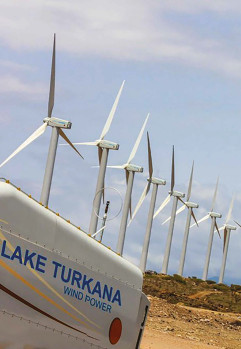Kenya: An Emerging African Leader on Renewable Energy
Kenya has taken a major leap forward in implementing an ambitious plan of ensuring access to power for all Kenyans by 2020.
On July 19, the President of Kenya Uhuru Kenyatta commissioned the 365-turbine Lake Turkana Wind Power Project, believed to be Africa’s largest such project to date. It project will add 310 megawatts (MW) of clean, reliable, low-cost electricity to Kenya’s national electricity grid.
“The successful implementation of the Lake Turkana Wind Power Project demonstrates Kenya’s outstanding credentials as an investment destination in Africa and is a perfect example of the immense potential of the public-private partnership model for implementing development projects,” said Kenyatta. The project is thought to have already saved Kenya more than $77.5 million in the past eight months due to lower consumption of expensive, diesel-generated thermal power. Over the same period, the plant injected more than 1.2 billion kilowatt hours (KWh) of electricity into the national grid. Kenya’s energy minister Charles Keter has estimated that the country will save at least $150 million annually on fuel imports because of the project.
This initiative follows up on the pledge President Kenyatta made at the Paris Peace Forum last November to expand the country’s renewable energy investments to mitigate climate change by reducing Kenya’s carbon footprint, all the while creating much-needed jobs. Additional goals are ensuring all Kenyans have access to electricity and lowering the cost of doing business, which should be a boon for its manufacturing sector.
Kenya is working with private investors to scale up a previous renewable energy investment plan from 2011. The plan aims to build more green energy plants to reduce reliance on electricity generated by thermal stations. At present, about 35 percent of Kenya’s electricity comes from such thermal power plants that are run on imported petroleum products.
According to Luca Marena, Program Manager for Sub-Saharan Africa at Renewable Energy Solutions for Africa (RES4Africa), a Rome-based nongovernmental organization, this is a positive development given East Africa’s current energy shortage despite its great potential for renewable energy. The World Bank, in a report published on July 24, warned that Kenya needed to create at least 900,000 jobs annually in the next five years to absorb the high number of youths joining the job market.
“The successful implementation
of the Lake Turkana Wind Power
Project demonstrates Kenya’s
outstanding credentials as an
investment destination in Africa
and is a perfect example of the
immense potential of the publicprivate
partnership.”
Marena said: “When comparing renewable energy to fossil fuel energy in terms of job creation and employment, renewables are more labor intensive, whereas fossil fuel energy tends to be more capital intensive. Renewable energy generally creates more jobs per dollar invested than conventional electricity generation technologies.” Marena added that renewables also tended to be bigger job creators when measured by energy delivered i.e. per average megawatt.
Wind power was first piloted in 1993 in the Ngong Hills, about 25 km southwest of Kenyan capital Nairobi. That project was spearheaded by the Kenyan power company KenGen, comprised two wind turbines, and was financed by a donation from the Belgian government. Until the Lake Turkana project, it was the only wind farm connected to the national grid.
The ministry of Energy set a target of increasing wind energy to at least 1,246 MW by harnessing public- private investment partnerships. The partnerships will be bound by the so-called feed-in tariff policy, according to which the tariff cannot exceed 12 U.S. cents per kilowatt hour of electrical energy supplied in bulk to the grid for wind generated electricity. Some sector providers, however, see the policy as an impediment to future investments.
“The challenge is to have an effective legislative and regulatory framework for the renewable energy sector that whets investors’ appetites. Sound policies and regulations are key to building constructive partnerships between public and private actors to accelerate Africa’s energy transition,” said Marena.
Kenya’s installed power capacity increased from 1,768 MW in March 2013 to the current 2,712 MW. Over the past year, the Lake Turkana wind power plant, the Garissa solar power plant (54 MW) and the Ngong wind plants (26 MW) have joined the grid.
Under a plan adopted in June 2018, Kenya aims to grow capacity for fixed maximum technical potential from 2,235 MW in 2017, to 7,214 MW in 2030, rising to 9,932 MW in 2037. Over the same period, it wants wind and solar to become major sources of electricity, generating 8.5 percent and 8.6 percent respectively of the total, while geothermal and hydropower’s share of the total is projected to fall, respectively, from 29.1% to 26.7%, and from 36% to 17.9%.
“African governments should choose clean and sustainable renewable energies instead of fossil fuels. Nevertheless, it is important to promote investments through open and transparent mechanisms, like competitive auctions, to attract the best players in the sector,” Marena said.
According to the World Bank, an estimated 13 percent of the world’s population lives without electricity. In Africa, about one in three people rely on kerosene to light their homes. Between 2014 and 2018, the World Bank provided more than $11.5 billion in financing for renewable energy and energy efficiency with a focus on Sub-Saharan Africa where the need for development is most acute.
United Nations Sustainable Development Goal 7 calls for universal access to affordable, reliable, and sustainable energy by 2030. To meet this goal, the World Bank is encouraging private sector investment in mini-grid initiatives to support cost-effective and reliable electrification of rural areas. Kenya is fast becoming a global leader in developing renewable energy, especially in the geothermal sector.








